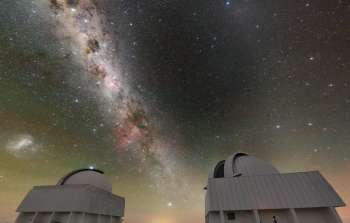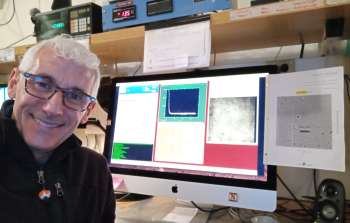sci24060 — Announcement
SMARTS Telescopes Return to Service
September 5, 2024
We are pleased to announce that the Small and Moderate Aperture Research Telescope System (SMARTS) is back on-sky.
Between 2003 and 2023, the SMARTS Consortium operated up to four small telescopes on Cerro Tololo in Chile: a 0.9-meter Telescope, a 1.0-meter Telescope, a 1.3-meter Telescope, and a 1.5-meter Telescope.
SMARTS is continuing in a new two-facet structure and the telescopes and their work will live on under two different entities. The 1.5-meter and 0.9-meter will be operated by the Georgia State University Research Foundation and will be known as SMARTS-GSU. University of North Carolina and the Astronomical Research Institute have partnered to operate the 1.0-meter and 1.3-meter.
SMARTS-GSU returned to service on 16 August, with astronomer Todd Henry of Georgia State University using the 0.9-meter Telescope, where a long-term program to observe red dwarf stars has been underway since 16 August 1999. To mark the occasion, Henry observed the nearby star GJ 1207, the first star observed 25 years ago, when he and astronomer Phil Ianna kicked off a three-year survey program.
SMARTS-GSU will be used for the RECONS (REsearch Consortium On Nearby Stars) program, which measures the distances to nearby stars and detects unseen companions in orbit around the stars. RECONS has been performing these observations for 25 years, creating an unprecedented catalog of star measurements. The same images used to measure distances and orbits are used to measure brightness fluctuations caused by starspots, revealing cycles similar to our own Sun’s 11-year cycle.
Tyler Linder is at the helm of the 1.0 and 1.3-meter telescopes that are now known as the Planetary Defense Telescopes, reflecting their primary mission to carry out southern skies astrometric follow-up observations of Near-Earth Asteroids (NEAs). In 2017 the 1.0-meter was automated, followed by the 1.3-meter in 2022, thanks to NASA awards for carrying out rapid astrometric and photometric observations of NEAs. Using the 1.0 and 1.3-meter together allows not only more asteroids to be monitored each night, but also simultaneous observations to rapidly characterize asteroids after discovery.
About the Announcement
| Id: |
ID
sci24060
|

